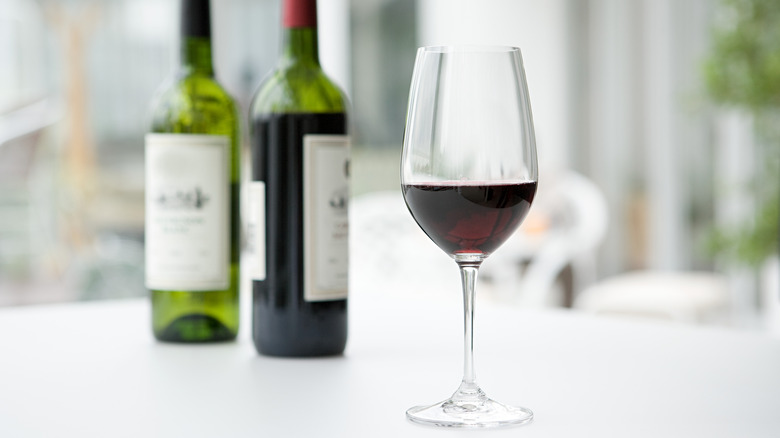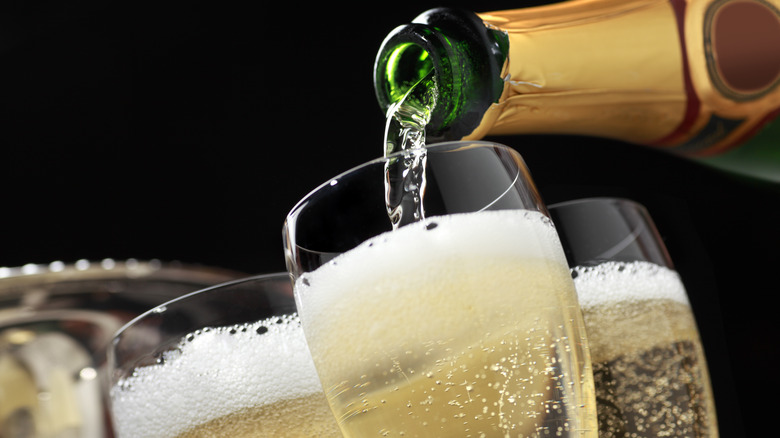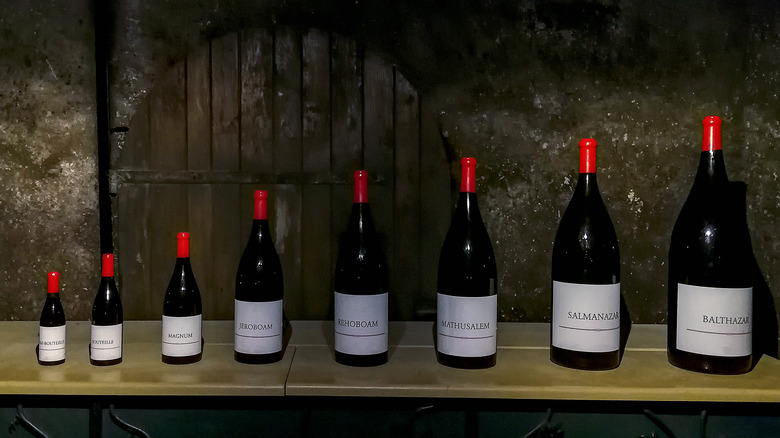How Many Glasses Are Actually In Your Bottle Of Wine?
If you've ever awakened with a raging headache after drinking "just two" glasses of wine, we've got news (and some answers) for you: There's a good chance that what you thought of as one glass of wine doesn't actually fit the U.S. Department of Agriculture's measure of what counts as one serving, which is five ounces. In general, people are pretty bad at estimating how much alcohol they're pouring into their glass, so we're here to settle things once and for all.
The USDA says one serving of wine is five ounces, and Wine Folly explains that a regular bottle of wine contains 750 milliliters or 25 ounces of liquid. That means there are five glasses of wine in each bottle.
That's the official count, but depending on your circumstances (and drinking companions), the actual number of glasses you get from a bottle might stray from that number. If you're serving wine with a high alcohol content like a Zinfandel or a fortified wine, you might want to pour a little less. If you're hosting a party for wine lovers, you might want to count on four glasses per bottle of wine rather than five, anticipating more generous pours. However, it also depends on the size of your wine bottle, and whether the wine you're serving is sparkling or still.
How many glasses are in a bottle of sparkling wine?
The rules for how many glasses are in a bottle of wine change when you're talking about sparkling wine, especially since they're are so many bottle sizes available. A serving of sparkling wine is considered to be four ounces, according to Champagne maker G.H. Mumm, which means there are six glasses of sparkling wine or Champagne in a standard 750 ml bottle. But sparkling wines and Champagne often come in a half-bottle size as well, which would contain just three glasses of wine.
Another thing to keep in mind is that the serving size for a Champagne toast is smaller. For a toast, you're more likely to get about six to seven glasses per bottle. Some wedding planners and caterers will go for even smaller pours to stretch a bottle to eight glasses. You might also see sparkling wine and Champagne served in a split (i.e. a miniature bottle of Champagne), which contains about 6 ounces, making for one generous serving.
Then, there's canned wine. There really isn't a standardized can size for wine, meaning you might be sipping from a 187-milliliter can that's equal to slightly more than one glass all the way up to a 500-milliliter can that has more than three glasses inside. You'll typically see cans in the 250- to 375- 375-milliliter range, but pay attention to the size of the can before you start imbibing, so you can keep track of how many "glasses" of wine you're actually drinking.
How many glasses are in a magnum?
If you've ever gone to a lavish wedding, visited a winery, or eaten at a restaurant that prides itself on its wine cellar, then you may have seen bottles of wine that seem twice, or even twenty times, as large as a standard bottle of wine. These specialty bottles are meant to serve crowds. The most common size is a magnum, which is 1.5 liters, the equivalent of two bottles of wine, which holds 12 glasses of sparkling wine or 10 glasses of still wine.
Even larger still? A 15-liter bottle containing 100 glasses of wine called the Nebuchadnezzar. But the largest bottle of wine in the world, according to Masterclass, is the Melchizedek or Midas, which contains 40 bottles of wine or 200 glasses. But chances are you'll never encounter bottles of this size.
In general, you can consider a standard bottle of wine to contain five glasses of still or six glasses of sparkling wine, which should be helpful to know the next time you're planning a party or want to keep better track of how much wine you're drinking over the course of a night out. Hopefully, it will help you avoid that hangover.


